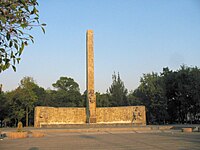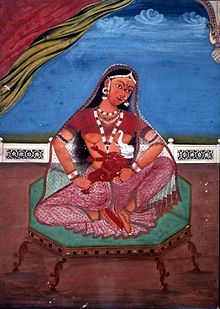Mother: Difference between revisions
edit semi request |
No edit summary |
||
| Line 4: | Line 4: | ||
{{Other uses}} |
{{Other uses}} |
||
{{pp-semi|small=yes}} |
{{pp-semi|small=yes}} |
||
[[Image: |
[[Image:Baby_got_Back.jpg|200px|thumb|right| Mother and child ]] |
||
A '''mother''' is a woman who has [[Pregnancy|conceived]], given [[Childbirth|birth]] to, or [[Parenting|raised]] a [[child]] in the role of a [[parent]].<ref>[http://www.allwords.com/word-mother.html Definition from Allwords.com]</ref> Because of the complexity and differences of a mothers' social, cultural, and religious definitions and roles, it is challenging to define a mother to suit a universally accepted definition. The masculine equivalent is a [[father]]. |
A '''mother''' is a woman who has [[Pregnancy|conceived]], given [[Childbirth|birth]] to, or [[Parenting|raised]] a [[child]] in the role of a [[parent]].<ref>[http://www.allwords.com/word-mother.html Definition from Allwords.com]</ref> Because of the complexity and differences of a mothers' social, cultural, and religious definitions and roles, it is challenging to define a mother to suit a universally accepted definition. The masculine equivalent is a [[father]]. |
||
Revision as of 17:14, 27 October 2010

A mother is a woman who has conceived, given birth to, or raised a child in the role of a parent.[1] Because of the complexity and differences of a mothers' social, cultural, and religious definitions and roles, it is challenging to define a mother to suit a universally accepted definition. The masculine equivalent is a father.
Biological mother
In the case of a mammal such as a human, a pregnant woman gestates a fertilized ovum. A fetus develops from the viable fertilised ovum or 'embryo'. Gestation occurs in the woman's uterus from conception until the fetus (assuming it is carried to term) is sufficiently developed to be born. The woman experiences labor and gives birth. Usually, once the baby is born, the mother produces milk via the lactation process. The mother's breast milk is the source of anti-bodies for the infant's immune system and commonly the sole source of nutrition for the first year or more of the child's life.[2][3][4]
Non-biological mother

Mother can often apply to a woman other than the biological parent, especially if she fulfills the main social role in raising the child. This is commonly either an adoptive mother or a stepmother (the biologically unrelated wife of a child's father). The term "othermother" or "other mother" is also used in some contexts for women who provide care for a child not biologically their own in addition to the child's primary mother.
Surrogate mother
A surrogate mother is, commonly, a woman who bears an embryo, that is from another woman's fertilized ovum, to term for a couple biologically unable to have children. Thus, she carries and gives birth to a child that is she not the biological mother of. Note that this is different from a woman who becomes pregnant via in vitro fertilization.
Currently, with advances in reproductive technologies, the function of biological motherhood can be split between the genetic mother (who provides the ovum) and the gestational (commonly known as a surrogate) mother (who carries the pregnancy).
Social role
Mothers have historically fulfilled the primary role in raising children, but since the late 20th century, the role of the father in child care has been given greater prominence and social acceptance in some Western countries.[5][6]
The social role and experience of motherhood varies greatly depending upon location. The organization Save the Children has ranked the countries of the world, and found that Scandinavian countries are the safest places to give birth, whereas countries in sub-Saharan Africa are the least safe to give birth.[7] This study argues a mother in the bottom ten ranked countries is over 750 times more likely to die in pregnancy or childbirth, compared to a mother in the top ten ranked countries, and a mother in the bottom ten ranked countries is 28 times more likely to see her child die before reaching their first birthday.
Mothers are more likely than fathers to encourage assimilative and communion-enhancing patterns in their children.[8] Mothers are more likely than fathers to acknowledge their children's contributions in conversation.[9][10][11][12] The way mothers speak to their children is better suited to support very young children in their efforts to understand speech (in context of the reference English) than fathers.[9]
Since the 1970s, in vitro fertilization has made pregnancy possible at ages well beyond "natural" limits, generating ethical controversy and forcing significant changes in the social meaning of motherhood.[13][14] This is, however a position highly biased by Western world locality: outside the Western world, in-vitro fertilization has far less prominence, importance or currency compared to primary, basic healthcare, women's basic health, reducing infant mortality and the prevention of life-threatening diseases such as polio, typhus and malaria.
Also around the 1970s, western attitudes towards the role of women and mothers in society began to change. Females were given more opportunities within the workforce and this resulted in more females becoming mothers for the first time at a later age. This trend peaked within the 1990s, but has since returned to a more traditional view point of fathers being to main breadwinner and mothers taking responsibility for the home and children.[15]
US motherhood statistics
Assorted and non-inclusive statistics on motherhood from the U.S. Census Bureau:[16]
- 82.5 million women are mothers of all ages in the United States.
- 68% of women aged 15 to 44 are mothers in Mississippi, considered high in comparison to a national average for same age group of 56%.
- 82% of women aged 40 to 44 years old are mothers.
- 4.0 million women give birth annually, approximately 425,000 were teenage mothers (aged 15 to 19) and more than 100,000 were aged 40 or over.
- 25.1 years of age is the national average age of women for their first births, a record high an increase of 4 years since 1970.
- 40% of annual births are the mother's first. Another 32 percent are the second-born; 17 percent, third; and 11 percent, fourth or more.
- 35,000 births in 2002 were attended by physicians, midwives or others outside a hospital facility.
- 55% of mothers with infant children in 2002 were employed, down from the record 59 percent in 1998, the first significant decline since the Census Bureau began collating such data in 1976. In 1976, 31% of mothers with infants were employed.
- 63% of employed women with infant children are college-educated.
- 72% of employed women, between ages 15 and 44 are mothers without infants.
- 687,000 child day-care centers operated in the USA in 2002. Of these, 69,000 centers employed close to 750,000 workers and another 618,000 were self-employed persons or companies without paid employees. Many mothers use such centers to juggle the demands of motherhood and career.
Religious
Nearly all world religions define tasks or roles for mothers through either religious law or through the deification or glorification of mothers who served in substantial religious events. There are many examples of religious law relating to mothers and women.
Major world religions which have specific religious law or scriptural canon regarding mothers include: Christians,[17] Jews,[18] and Muslims.[19] Some examples of glorification or deification include the Madonna or Blessed Virgin Mother Mary for Christians, the Hindu Mother Goddess, or Demeter of ancient Greek pre-Christian belief.
Synonyms and translations
The proverbial "first word" of an infant often sounds like "ma" or "mama." This strong association of that sound with "mother" has persisted in nearly every language on earth, countering the natural localization of language.
Familiar or colloquial terms for mother in English are:
- Mom and mommy are used in the USA, Canada, South Africa, Philippines, and the West Midlands of England.
- Mum and mummy are used in the UK, Canada, Singapore, Australia, New Zealand, and Ireland.
- Ma, mam, and mammy are used in Netherlands, Ireland, the Northern areas of the UK, and Wales; it is also used in some areas of the US.
- Maa,aai, amma, and mata are used in India and sometimes in neighboring countries, originating from the Sanskrit matrika and mata

In many other languages, similar pronunciations apply:
- mamá, ma, and mami in Spanish language
- mama in Polish, German, Russian and Slovak
- māma (妈妈/媽媽) in Chinese and Japanese
- máma in Czech and in Ukrainian
- maman in French and Persian
- ma, mama in Indonesian
- mamma in Italian, Icelandic and Swedish
- mamãe or mãe in Portuguese
- mã in Punjabi
- mama in Swahili
- em (אם) in Hebrew
- ima (אמא) in Aramaic
- má or mẹ in Vietnamese
- mam in Welsh
- eomma (엄마, pronounced [ʌmma]) in Korean
- In many south Asian cultures and the Middle East, the mother is known as amma or oma or ammi or "ummi", or variations thereof. Many times, these terms denote affection or a maternal role in a child's life.
Famous motherhood figures

- Bachue
- Bithiah
- Demeter
- Yashoda
- Dewi Sri
- Eve
- Gaia
- Isis
- Jocasta
- Juno
- Kwan Yin
- Mary
- Parvati
- Queen Maya
- Sita
- Venus
See also
- Attachment parenting
- Blessed Virgin Mary
- Breastfeeding
- Human bonding
- Jungian archetypes
- Lactation
- Matriarch
- Matricide
- Matrilocal residence
- Mother goddess
- Mother Goose
- Mother insult
- Mother ship
- Mother's Day
- Mothers rights
- Nuclear family
- Oedipus complex
- Othermother
- Parenting
- Single-parent
- The mother of all
References
- ^ Definition from Allwords.com
- ^ Dhushara.com
- ^ Growth and Development
- ^ Chapter 46 Animal Reproduction
- ^ "In most Western countries the family model of a sole male breadwinner is in full retreat." Accessed 19 September 2007.
- ^ Why Are Fathers Important? Interview with Dr. Ross Parke, professor of psychology at the University of California at Riverside, author of Fatherhood (1966) and co-author of Throwaway Dads (1999). Accessed 19 September 2007.
- ^ Save the Children, State of the World's Mothers Report 2006.
- ^ Gendered differences in parents' encouragement of sibling interaction: implications for the construction of a personal premise system
- ^ a b Fathers' speech to their children: perfect pitch or tin ear?
- ^ Hladik, E., & Edwards, H. (1984). A comparison of mother-father speech in the naturalistic home environment. Journal of Psycholinguistic Research, 13, 321-332.
- ^ Leaper, C., Anderson, K., & Sanders, P. (1998). Moderators of gender effects on parents' talk to their children: A meta-analysis. Developmental Psychology, 34, 3-27.
- ^ Mannle, S., & Tomasello, M. (1987). Fathers, siblings, and the bridge hypothesis. In K.E. Nelson & A. vanKleeck (Eds.), Children's language, Vol. 6, (pp. 23-42). Hillsdale, NJ: Erlbaum.
- ^ Motherhood: Is It Ever Too Late?, July 15, 2009
- ^ Getting Pregnant After 50: Risks, Rewards July 17, 2009
- ^ "Australians more conservative on gender issues, working mothers". Sydney Morning Hearld. 11 October 2010. Retrieved 11 October 2010.
- ^ Census.gov
- ^ "What The Bible Says About Mother". Mothers Day World. Retrieved 2008-11-24.
- ^ Katz, Lisa. "Religious Obligations of Jewish women". About.com. Retrieved 2008-11-24.
- ^ 'Ali Al-Hashimi, Muhammad. The Ideal Muslimah: The True Islâmic Personality of the Muslim Woman as Defined in the Qur'ân and Sunnah. Wisdom Enrichment Foundation, Inc. Retrieved 2008-11-24.
Further reading
- Thornhill, Randy; Gangestad, Steven W. The Evolutionary Biology of Human Female Sexuality.
- Manne, Anne. Motherhood - How should we care for our children?.
- Hrdy, Sarah Blaffer. Mother nature: maternal instincts and how they shape the human species.
Template:Articles of the Universal Declaration of Human Rights
